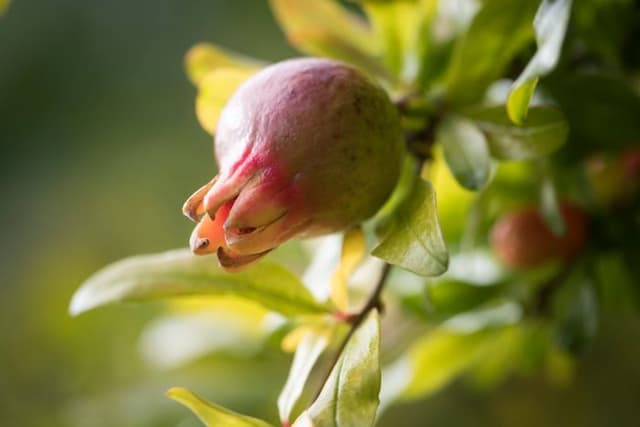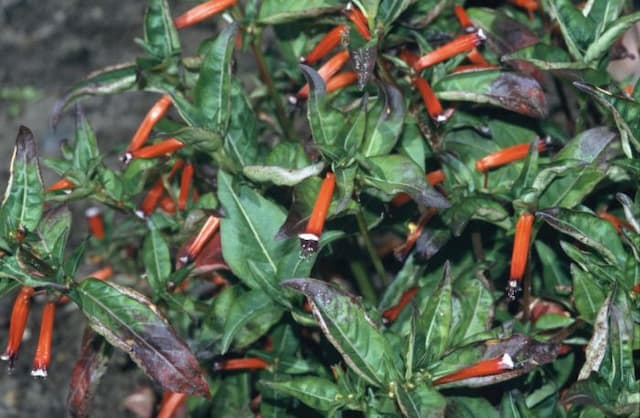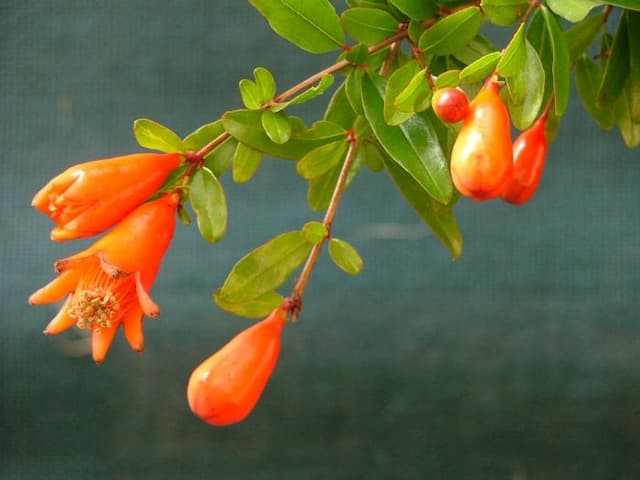Dropmore Purple Loosestrife Lythrum virgatum 'Dropmore Purple'

ABOUT
The plant known as 'Dropmore Purple' is an ornamental perennial that displays strikingly vibrant purple flowers. These blossoms are arranged in elongated, spike-like clusters that add dimension and texture to the visual presentation. The flowers themselves have a tubular shape, which is attractive to pollinators such as bees and butterflies. The foliage of 'Dropmore Purple' is also noteworthy, consisting of lance-shaped leaves that are generally smooth, with a rich green color that contrasts nicely with the purple flowers. The leaves are arranged oppositely along the sturdy stems, which contribute to the plant's overall bushy look. The plant has a tendency to spread, creating a full and lush appearance in the garden. Its colorful and lasting blooms can be observed from midsummer into the fall, offering a prolonged period of visual interest. Overall, 'Dropmore Purple' is recognized for its vibrant flowers, attractive foliage, and ability to bring a pop of color and life to garden spaces.
About this plant
 Names
NamesFamily
Lythraceae.
Synonyms
European Wand Loosestrife, Dropmore Purple Loosestrife.
Common names
Lythrum virgatum 'Dropmore Purple'.
 Toxicity
ToxicityTo humans
The European wand loosestrife is not generally considered toxic to humans. There are no well-documented cases of poisoning from ingesting this plant, and it is not widely recognized for having harmful effects upon consumption. However, it is always best practice to avoid eating any part of ornamental plants as they are not intended for human consumption and could pose potential health risks. In general, if any plant material of unknown toxicity is ingested, it is advisable to seek medical attention to ensure safety.
To pets
The European wand loosestrife is also not commonly known to be toxic to pets. There is no significant evidence suggesting that this plant poses a poisoning risk to animals such as dogs and cats. As with humans, it is recommended that pets are discouraged from ingesting plants not specifically intended for their consumption, as there could be individual cases of adverse reactions. If a pet does consume any part of this plant and exhibits unusual symptoms, it would be wise to consult a veterinarian.
 Characteristics
CharacteristicsLife cycle
Perennials
Foliage type
Deciduous
Color of leaves
Green
Flower color
Purple
Height
3-4 feet (0.91-1.22 m)
Spread
1-2 feet (0.30-0.61 m)
Plant type
Herb
Hardiness zones
4-9
Native area
Europe Asia
Benefits
 General Benefits
General Benefits- Attracts Wildlife: Lythrum virgatum 'Dropmore Purple', also known as European wand loosestrife, draws in pollinators like bees, butterflies, and hummingbirds, which are essential for the pollination of many plants.
- Aesthetic Appeal: With its striking purple flowers, the plant adds a splash of vibrant color to gardens and landscapes from early to late summer.
- Durability: It is a hardy perennial that can withstand various environmental conditions and is relatively low maintenance once established.
- Erosion Control: Its robust root system can help stabilize soil and reduce erosion on banks and slopes.
- Wildlife Habitat: The plant provides shelter and nesting sites for small wildlife, contributing to local biodiversity.
- Flexible Planting: It can thrive in wet environments, making it suitable for rain gardens, pond margins, and other damp areas.
- Garden Design: Can be used effectively in mass plantings, borders, or as a structural element within a perennial bed due to its upright growth habit.
 Medical Properties
Medical PropertiesThis plant is not used for medical purposes.
 Air-purifying Qualities
Air-purifying QualitiesThis plant is not specifically known for air purifying qualities.
 Other Uses
Other Uses- The dried stalks of Lythrum virgatum 'Dropmore Purple', also known as the wand loosestrife, can be used to create rustic crafts and homemade decorations, such as wreaths or wall hangings.
- The seeds of the wand loosestrife may serve as a food source for some bird species when left on the plant through the fall and winter months.
- Lythrum virgatum 'Dropmore Purple' has been utilized in dye production, with parts of the plant providing natural pigments for coloring fabrics.
- Fallen leaves of the wand loosestrife can be gathered and added to compost piles, providing a source of nutrients as they decompose.
- The structural form of the wand loosestrife can be inspirational for artists and photographers, particularly when capturing the interplay of light and shadow in landscapes and gardens.
- Lythrum virgatum 'Dropmore Purple' may be used in educational settings, such as schools or botanical gardens, as an example of a herbaceous perennial in teaching botany or horticulture.
- When planted near ponds or water features, the wand loosestrife can help stabilize soil and prevent erosion with its robust root system.
- In sustainable gardening practices, the wand loosestrife can be used as part of a rain garden to help manage water runoff in an environmentally friendly way.
- The tall, colorful spikes of Lythrum virgatum 'Dropmore Purple' provide a vertical element in floral arrangements, both in cut form or when used as a living component of the design.
- The wand loosestrife can act as a natural marker for seasonal change in gardens due to its dependable blooming period, notifying gardeners of the onset of summer.
Interesting Facts
 Feng Shui
Feng ShuiThe Loosestrife is not used in Feng Shui practice.
 Zodiac Sign Compitability
Zodiac Sign CompitabilityThe Loosestrife is not used in astrology practice.
 Plant Symbolism
Plant Symbolism- Beauty: The 'Dropmore Purple' variety, with its striking purple flowers, symbolizes beauty in the plant world due to its visually appealing appearance.
- Vibrancy: The vivid purple color is often associated with vibrancy and dynamism, representing a lively or energetic spirit.
- Abundance: Lythrum species, commonly known as loosestrife, can grow prolifically, often symbolizing abundance or profusion.
- Healing: In some cultures, members of the Lythrum genus are associated with healing due to their use in traditional herbal remedies.
 Water
WaterWater the Purple Loosestrife moderately, aiming to keep the soil consistently moist without it becoming waterlogged. During the growing season, it's common to water thoroughly once or twice a week, depending on the temperature and soil drainage. In hotter periods, you may need to water more frequently, paying attention to the top inch of soil; once it feels dry, it's time to water again. Start with approximately 1 gallon of water per plant for each watering session, adjusting as necessary for the size of the plant and weather conditions. Be cautious not to overwater, as standing water can lead to root problems.
 Light
LightThe Purple Loosestrife thrives best in full sunlight, which means at least 6 hours of direct, unfiltered sunlight per day. It's adaptable and can also tolerate partial shade, but it will produce the most vigorous growth and best flowering when planted in a spot that receives uninterrupted sunlight. Avoid placing it in full deep shade, as this will result in fewer flowers and leggy stems.
 Temperature
TemperaturePurple Loosestrife is hardy in a range of temperatures, withstanding winter lows of around -30°F and summer highs of 90°F or above. It performs best when daytime temperatures are between 60°F and 70°F, which promotes optimal growth and flowering. Ensure to protect the plant from extreme cold by providing mulch or shelter if temperatures fall significantly below the survival threshold.
 Pruning
PruningPrune Purple Loosestrife to maintain its shape and encourage bushier growth. Cut back the stems by one-third in late winter or early spring before new growth begins. Additionally, deadhead spent flowers during the blooming season to stimulate more blooms. Pruning can also be performed as necessary to remove any damaged or diseased stems, keeping the plant healthy and well-groomed.
 Cleaning
CleaningAs needed
 Soil
SoilWand Loosestrife 'Dropmore Purple' thrives in rich, moist soil with good drainage and a pH range of 5.5 to 7.5. A soil mix comprising loam, peat, and some sand is ideal to provide the necessary fertility and moisture retention while avoiding waterlogging.
 Repotting
RepottingWand Loosestrife 'Dropmore Purple' typically does not require frequent repotting and can be repotted every 2-3 years as it prefers to establish itself without disturbance, or when it has outgrown its current container.
 Humidity & Misting
Humidity & MistingWand Loosestrife 'Dropmore Purple' is tolerant of a wide range of humidity levels and does not require specific humidity conditions; however, it thrives in environments that mimic its natural wetland habitat.
 Suitable locations
Suitable locationsIndoor
Grow in moist soil, bright light, and keep room temperatures consistent.
Outdoor
Plant in full sun to partial shade, water regularly, and ensure soil remains moist.
Hardiness zone
4-9 USDA
 Life cycle
Life cycleThe life of the Lythrum virgatum 'Dropmore Purple', commonly known as Dropmore Purple Loosestrife, begins with seed germination, typically occurring in spring under the right moisture and temperature conditions. After germination, the seedlings establish themselves and transition into vegetative growth, developing a robust root system and elongated stems with lance-shaped leaves. During the summer, the plant enters its reproductive phase, producing tall spikes of vivid purple flowers that attract pollinators and facilitate cross-pollination. Following pollination, seeds are produced and dispersed, either by wind, water, or wildlife, to initiate a new cycle. As winter approaches, the above-ground portions of the plant die back, while the root system goes dormant until the next spring. This perennial plant can also spread clonally through its root system, creating new shoots and expanding its growth footprint annually.
 Propogation
PropogationPropogation time
Late summer
The most popular method of propagation for 'Dropmore Purple' Loosestrife, Lythrum virgatum 'Dropmore Purple', is by division of its root system. This is typically done in the spring, just as new growth begins to appear. To propagate by division, carefully lift the plant from the soil, using a shovel to minimize root damage. Once lifted, use a sharp knife or spade to slice through the root ball, ensuring that each division contains several shoots and a portion of the root system. Replant the divisions immediately at the same depth they were originally growing and water well. This method allows the plant to establish quickly, with minimal stress, and typically ensures a healthy, blooming plant in the following season.




